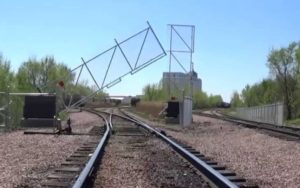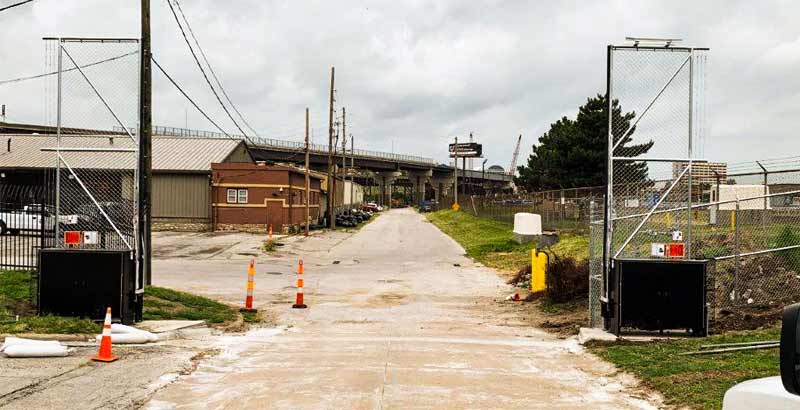Vertical Pivot Gates | American Security and Gate Company – Fargo, ND
Because automated gates are essential to controlling entry at commercial and industrial facilities, every precaution should be made to prevent unwanted gaps through which intruders can slip. While most facilities default to swing and slide gates, those particular barrier types are not the top choice for areas with uneven terrain. Curbs, changes in elevation, contours, drainage swales — all of these create gaps between the grade and the bottom of your gate. If you can crawl underneath, so can animals and unauthorized personnel.
What’s more, swing and slide gates tend to eat up a lot of storage space. To counter all of these problems, we at American Security and Gate Company of Fargo, North Dakota recommend vertical pivot gates. Fast-moving and built to last, these gates can be designed to fit the grade of your facility’s entry point.
For a free estimate:
 How Does a Vertical Pivot Gate Work?
How Does a Vertical Pivot Gate Work?
Thanks to their lightweight build, these gates operate on a single pivot point. When opening, the gate lifts on its pivot — located to one side of the designated entry/exit — until it stands vertically. It moves very much in the manner of a railroad crossing arm. (Fittingly enough, vertical pivot gates are a common installation on railroad tracks.) When the gate is fully open, vehicles of all heights — including semi-trucks and trains — can pass by without bumping into it.
What Are the Advantages to Having a Vertical Pivot Gate?
Swing and slide gates provide security and permit authorized vehicle entry, so what makes vertical pivot gates a superior alternative? As mentioned at the top, the gates under discussion can be designed to accommodate their surroundings. In areas with curbs and uneven grading, swing and slide gates tend to leave gaps between themselves and the ground, which are not only unsightly but also inviting for intruders. Having a gate engineered to fill these gaps boosts your security and curb appeal.
Vertical pivot gates are also very storage-compatible, usually requiring less than ten feet of storage space along the gate opening (less than half the length of the actual gate). Downtown parking lots frequently use vertical pivot gates for this reason.
For a free estimate:
Faster Vehicle Entry
Being lighter in weight, these gates open/close much quicker and smoother than their slide and swing counterparts. Whereas other automated gates typically process one successful vehicle entry per minute, vertical pivot gates are able to accommodate two or three automobiles in the same amount of time.
Quicker entry is beneficial on multiple fronts. The slower entry provided by swing and slide gates means drivers are more likely to become antsy as they wait their turn — thereby increasing the odds of vehicles either bumping into one another or bumping into your gate. The more efficient speed of vertical pivot gates allows your facility to process vehicular traffic faster, and thereby reduce the likelihood of accidents.
Vertical Pivot Gates Work in Snow Country
One of the disadvantages to using swing gates in outdoor environments is that they operate parallel to the ground — meaning they’ll push against anything caught in their path of movement. Such as snowfall accumulated on the ground. This is especially true here in Fargo, North Dakota, where winters tend to be harsh, snowy, and rampant with blizzards. However, because vertical pivot gates move vertically, you don’t have to worry about them becoming snagged against snowbanks.
Greater Damage Resistance, Less Maintenance
Whereas swing and slide gates are attached to fences and support posts — and often feature components exposed to the elements — vertical pivot gates are bolted to their operators and feature secure footing within concrete. The parts that operate the gate are contained within. So if a collision does occur, damage should be confined to the gate (easy to repair) rather than the operator parts.
Vertical pivot gates have been a popular entry device choice for more than 40 years. While they require considerable footing and concrete to support the operator — and while there is more cost involved in installation — the benefits of this type of gate make it a great investment for commercial and industrial complexes.

